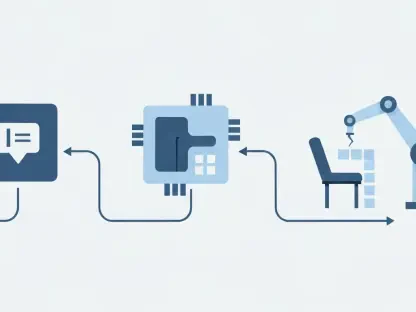As artificial intelligence continues to embed itself deeper into the fabric of modern technology, the data architecture supporting these AI endeavors is evolving at an unprecedented pace. Traditional data management systems are rapidly becoming obsolete in the wake of sophisticated AI’s growing demands and complexities. Enter the data lakehouse, a transformative data architecture that marries the strengths of data lakes and data warehouses to provide a robust, adaptable solution for modern enterprises. This new paradigm is not merely an incremental advancement but a fundamental shift in how businesses approach their data strategies. It is designed to meet the challenges posed by AI and machine learning, offering enterprises the agility and power they need to thrive in a data-intensive world.
Redefining Modern Data Architectures
The Limits of Conventional Systems
Businesses globally are recognizing that traditional data platforms, like data warehouses, struggle with the dynamic nature and vast demands of AI workloads. These conventional systems, characterized by strict schemas and substantial overhead costs, have been adequate for historical data analysis but falter in real-time analytics and flexibility requirements essential for AI. Data lakes, on the other hand, while offering more versatile data storage capabilities, fall short on managing and optimizing high-performance analytics. They lack the governance and query efficiencies critical for actionable insights into diverse data.
The data lakehouse model emerged to address these deficiencies by bridging the gap between data lake flexibility and data warehouse reliability. It supports diverse data types—structured, semi-structured, and unstructured—making it particularly suited for comprehensive AI functions. As a result, it empowers enterprises to harness the full spectrum of data-driven insights by supporting real-time processing capabilities. This ensures that businesses can keep pace with AI’s ever-evolving requirements and leverage data to fuel innovative AI-driven solutions and strategies.
Key Features of Lakehouse Architecture
At the heart of the data lakehouse approach is its capacity to deliver consistent, timely access to data, a must-have for modern AI applications which thrive on fresh and multifaceted data streams. The architecture integrates advanced data governance mechanisms to ensure data quality and compliance, crucial for maintaining trust in AI systems. Moreover, it incorporates sophisticated query optimization features, allowing businesses to perform complex analytical operations swiftly, thus enhancing decision-making processes across the board.
Another vital aspect is the lakehouse’s ability to seamlessly support mixed workloads in a singular environment, combining reporting, machine learning, and data processing tasks without the need for separate systems. It accommodates evolving technology landscapes by providing a scalable, cost-efficient platform capable of adapting to increasing data volumes and AI demands. This flexibility is a key differentiator from its traditional counterparts, enabling organizations to future-proof their data strategies while remaining agile and responsive to technology trends and business changes.
Transforming AI and Business Intelligence
Transitioning from Reactive to Proactive Systems
In the contemporary business environment, merely reacting to data trends is no longer sufficient. The transition to the data lakehouse model underscores a shift from reactive data systems to proactive AI enablers. This shift places data platforms at the core of innovation, helping companies move beyond simple analysis of past performances to predictive and prescriptive analytics that drive future strategies. The data lakehouse’s real-time analysis capabilities facilitate immediate insights, a crucial advantage in competitive markets where timely information can dictate success.
By enabling continuous feedback loops of real-time data, the lakehouse architecture empowers both human decision-makers and automated systems to make informed choices quickly. This capability makes it possible for organizations to create strategies that are informed by data-driven foresight rather than hindsight, aligning business decisions with AI insights for maximum effectiveness and outcome optimization. Enterprises that integrate such adaptive systems into their operations are more likely to unlock new value streams and market opportunities.
Ensuring Seamless Integration with Existing Systems
Migrating to a data lakehouse does not necessitate an abrupt overhaul of existing infrastructure. Instead, it promotes a hybrid approach that integrates and enhances current systems while laying a foundation for future growth. This ensures continued leverage of prior investments in data warehouses for tasks such as financial reporting, while also adopting the lakehouse setup for broader AI and analytics functions. Such a strategy allows organizations to balance immediate needs with long-term goals, transitioning at their pace while aligning with strategic AI objectives.
The adaptability of the lakehouse approach allows businesses to incrementally modernize data pipelines and infrastructure without significant disruption. This gradual transition is vital in sectors with complex legacy systems or those undergoing digital transformation. By strategically integrating lakehouses with existing platforms, enterprises can extend the lifespan of their current systems while simultaneously embracing a more robust, future-ready data strategy that supports comprehensive AI integration and innovation.
The Strategic Imperatives of Data Lakehouses
Achieving Competitive Advantage in AI
For organizations looking to lead in modern industry landscapes, embracing data lakehouse architecture is increasingly seen as a strategic necessity rather than an optional upgrade. As AI continues to redefine competitive advantage, the ability to swiftly process and analyze data in innovative ways becomes indispensable. Traditional systems, like SQL Server, often fall short in scenarios demanding frequent retraining of models and real-time analytics. In contrast, lakehouses offer a unified architecture conducive to advanced analytics and real-time applications, pivotal for maintaining a competitive edge.
Key players within the data architecture sphere, such as Snowflake, Databricks, and AWS, are rapidly innovating to capture this transformative shift. Their solutions emphasize capabilities like semantic modeling and real-time observability, critical for enhancing AI operational efficiency. The ability to seamlessly accommodate these technologies in data strategies enables businesses to not only keep pace with competitors but to set new benchmarks in AI proficiency and business intelligence.
Building a Future-Ready Data Infrastructure
Finally, the path forward for decision-makers involves making comprehensive data infrastructure choices that will underpin AI-driven growth. Implementing a data lakehouse strategy involves meticulous planning in terms of data management and governance, supporting diverse inputs, and streamlining data pipelines. Prioritizing data integrity and governance over simple feature expansion is essential for maintaining a trustworthy data framework.
Firms must consider the semantic layers within their architecture to ensure clear data lineage and consistency, crucial for advanced analytics and skilled AI development. The strategic foresight gained through a well-implemented lakehouse approach can lead to the unlocking of new avenues of opportunity, spearheading innovation, and driving sustainable growth across industries. Successfully leveraging this architecture will involve collaborative efforts between IT, data professionals, and business strategists, all working towards unified goals.
Embracing the Next Frontier in Data Architecture
Globally, businesses are realizing traditional data platforms, like data warehouses, aren’t meeting the demands of AI workloads. These systems, with their rigid schemas and high overhead costs, were once sufficient for historical data analysis but now struggle with real-time analytics, a necessity for AI. Data lakes offer more flexible storage but fall short in handling high-performance analytics, lacking the necessary governance and query efficiency for actionable insights.
The data lakehouse model emerged as a solution, merging the flexibility of data lakes with the reliability of data warehouses. It supports structured, semi-structured, and unstructured data, making it ideal for comprehensive AI tasks. By facilitating real-time processing, it allows businesses to meet AI’s dynamic needs, unlocking a fuller spectrum of data-driven insights. This adaptiveness enables enterprises to innovate with AI, crafting strategies and solutions that keep pace with evolving technological demands. Therefore, data lakehouses empower firms to leverage data more effectively, driving AI-powered advancements.









